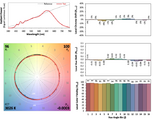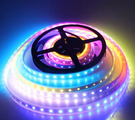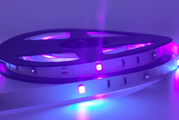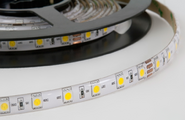Does the LED strip lights use AC or DC power? Why does the LED strip lights not light up?
Does the LED light strip use AC or DC power?
LED strip lights equipped with a constant current source use AC power. Those without a constant current source are lit by batteries and use DC power. LED strip lights that use DC power can also be equipped with a suitable constant current source and lit with AC power. Similarly, strip lights that use AC power can also be lit with a suitable DC power supply without the constant current source.
The difference between high-voltage LED strip lights and low-voltage LED strip lights
High-voltage LED strip lights are also called AC strip lights, and low-voltage LED strip lights are also called DC strip lights. So what are the differences between these two types of LED flexible strip lights? What are the advantages and disadvantages between them and how to choose? Let’s analyze the differences between the two.
Installation: The installation of high-voltage LED strip lights is relatively simple and can be driven directly by a high-voltage driver. Generally, it can be configured directly in the factory and it can work normally when connected to the 220V power supply. The installation of low-voltage LED flexible strip lights requires a DC power supply in front of the strip lights, which is relatively complicated to install.
Safety: High-voltage LED strip lights operate at a voltage of 220V, which is a dangerous voltage and may cause safety hazards in some risky situations. Low-voltage LED strip lights operate at a DC 12V operating voltage, which is a safe voltage and can be used in various situations. , there is no danger to the human body.
Packaging: The packaging of high-voltage LED strip lights is also very different from that of low-voltage LED strip lights. High-voltage LED flexible strip lights can generally be 50 to 100 meters per roll; low-voltage LED flexible strip lights can generally be up to 5 to 10 meters per roll; beyond The attenuation of DC power supply above 10 meters will be severe.
Price: If you look at the two types of strip lights alone, the prices of LED strip lights are about the same, but the overall cost is different because high-voltage LED strip lights are equipped with high-voltage power supplies. Generally, one power supply can carry 30 to 50 meters. LED flexible strip lights, and the cost of high voltage is relatively low. Low-voltage LED strip lights require an external DC power supply. Generally, the power of a 1-meter 60-bead 5050 light strip is approximately 11~14W, which means that each meter of light strip must be equipped with a DC power supply of about 15W. In this way, the low-voltage LED light strip The cost will increase a lot, much higher than that of high-voltage LED strip lights.
Therefore, from the overall cost point of view, the price of low-voltage LED lights is higher than that of high-voltage LED lights.
Service life: The service life of low-voltage LED strip lights will technically be 50,000-100,100 hours, but actual use can also reach 30,000-50,010 hours. Because of the high voltage, high-voltage LED strip lights generate much more heat per unit length than low-voltage LED strip lights, which directly affects the life of high-voltage LED strip lights. Generally speaking, the service life of high-voltage LED strip lights is about 10,000 hours. LED strip lights are often used to outline the outlines of various buildings, create large-scale lighting patterns, various interior decorations, residential areas, home beautification and other lighting decorations. According to the different use occasions of LED strip lights and the different requirements for the strip lights, it can be seen from the analysis that high and low voltage LED strip lights have their own advantages and disadvantages. Users are asked to make reasonable choices according to their different use environments so as not to waste resources.
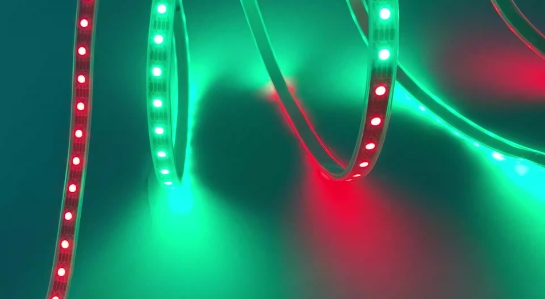
Why does the LED light strip not light up?
According to the analysis of LED display manufacturer Fengliyuan Optoelectronics Engineer: The reasons for this phenomenon include moisture bursting at high temperatures, static electricity burning, and high temperature damage.
1. Moisture explodes at high temperatures
If the LED package is exposed to the air for a long time, it will absorb moisture. If it is not dehumidified before use, the moisture in the LED package will expand due to the high temperature and long time period during reflow soldering, causing The LED package bursts, which indirectly causes the LED chip to overheat and be damaged.
Measures to prevent this phenomenon include: controlling the temperature of reflow soldering and soldering irons, implementing dedicated personnel, and special file management; using temperature-controlled soldering irons to effectively prevent the soldering iron from burning out the LED chip at high temperatures.
2. Static electricity burnout
Because LED is an electrostatically sensitive component, if the electrostatic protection work is not done well during the production process, the LED chip will be burned out due to static electricity, resulting in the LED light strip not lighting up. The measure to prevent this phenomenon is to strengthen electrostatic protection. All employees who come into contact with LEDs must wear anti-static gloves and electrostatic rings in accordance with regulations, and tools and instruments must be well grounded.
3. High temperature damage
The high temperature resistance of LED is not good. Therefore, if the welding temperature and welding time of LED are not well controlled during the production and maintenance process, the LED chip will be damaged due to ultra-high temperature or continuous high temperature, resulting in the failure of LED strip lights. The phenomenon of suspended animation.


